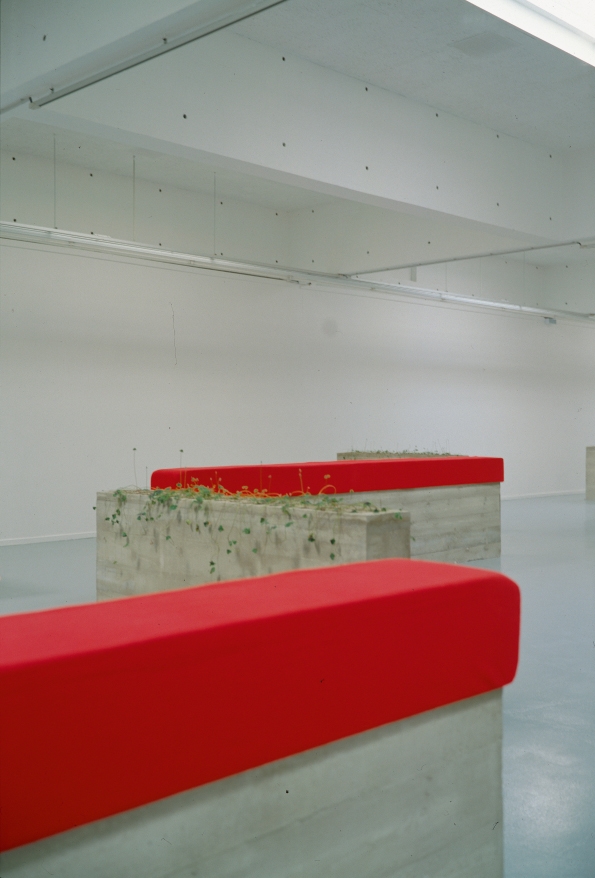Porte bonheur
8 June – 13 July 1989
Maison de la Culture et de la Communication de Saint-Étienne, France
Preliminary Room:
– “André Malraux,” 1989, photograph, passe-partout, framed; 30 x 26 inches
Exhibition Space:
– 17 concrete components, nine are planted with four-leafed clovers and eight are covered with red cloth
“Porte bonheur” was Christian Philipp Müller’s first collaboration with Yves Aupetitallot, then artistic director of the Maison de la Culture et de la Communication of the city of Saint-Étienne. In the spaces reserved for contemporary art on the seventh floor of the building, Müller installed 17 concrete units in a grid-like formation. Nine units were placed perpendicular to the long walls and planted with four-leaf clovers; the other eight, positioned parallel to the long walls, were supplied with red fabric covers. This 90-centimeter-tall configuration mirrored the structure of the concrete ceiling beams, projecting below ceiling level by the same dimension. From this concentration on structure, there emerged references to the institution’s significance and the context in which it was founded — the spirit of renewal in the French cultural politics of late modernism — references which Müller explored further in his project.
During his tenure as the first French Minister of Culture (1959–1969), André Malraux pursued a policy described by Aupetitallot in his introduction to the catalogue as “Malraux’s humanism.” Malraux’s desire to use culture to revitalize French society led to a program of decentralization in French cultural politics, with the establishment of independent cultural centers in the French periphery.
Inspired by Malraux’s “musée imaginaire” — an idea revisited by Müller in his artist’s book — masterworks from all areas were brought together in the exhibition, displayed, and made accessible to the public. Instead of documentary reproductions of the site-specific installation, Müller produced handmade paper on site with integrated pressed four-leaf clover leaves and had it scanned for the artist’s book.
“For the price of 25 kilometers of motorways and thanks to its Maisons de la Culture, France could, in the next ten years, become the world leader in the realm of culture.”[1] (André Malraux) Maisons de la Culture et de la Communication were established at this time in many cities in France, including Grenoble, Le Havre, and Firminy. Not only Le Corbusier, but other famous modern architects including Richard Neutra were invited by Malraux to develop a formal vocabulary for the Maisons. These institutions represented an attempt to establish culture as a center for society, as a restorative meeting place for diverse forms of expression.
In the Parisian uprisings of 1968, Malraux opposed the student youth and abandoned his vision of salutary culture: “All power to the imagination is a meaningless slogan. Imagination does not grab power; forces, which must be organized, do so. Politics is not what one wants, it is what one does.”[2] With the appointment of a new Minister of Culture and a new cultural-political orientation in France, the idea of the Maisons de la Culture et de la Communication became obsolete overnight.
Notes
- Pour le prix de 25 km d’autoroutes, la France peut, dans les dix années qui viendront, redevenir grâce aux maisons de la culture, le premier pays culturel du monde. Cited from Yves Aupetitallot, Christian Philipp Müller – Porte bonheur, Saint-Étienne 1989, S. p. 9.
- L’imagination au pouvoir, ça ne veut rien dire. Ce n’est pas l’imagination qui prend le pouvoir, ce sont des forces à organiser. La politique n’est pas ce qu’on désire, c’est ce qu’on fait. Cited from Aupetitallot 1989 (as in note 1).
Essay by Frederik Leen available here.

